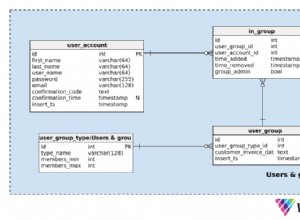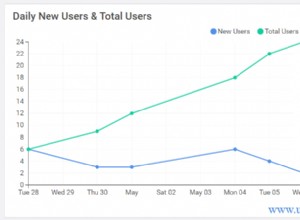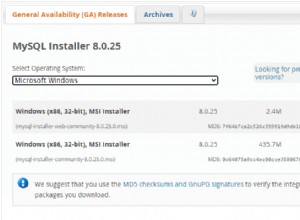यदि आप एक संग्रहीत कार्यविधि का उपयोग करते हैं, तो आप इसे php से mysql पर एक ही कॉल में कर सकते हैं:
उदाहरण कॉल
mysql> call category_hier(1);
+--------+---------------+---------------+----------------------+-------+
| cat_id | category_name | parent_cat_id | parent_category_name | depth |
+--------+---------------+---------------+----------------------+-------+
| 1 | Location | NULL | NULL | 0 |
| 3 | USA | 1 | Location | 1 |
| 4 | Illinois | 3 | USA | 2 |
| 5 | Chicago | 3 | USA | 2 |
+--------+---------------+---------------+----------------------+-------+
4 rows in set (0.00 sec)
$sql = sprintf("call category_hier(%d)", $id);
आशा है कि यह मदद करता है :)
पूरी स्क्रिप्ट
टेस्ट टेबल स्ट्रक्चर:
drop table if exists categories;
create table categories
(
cat_id smallint unsigned not null auto_increment primary key,
name varchar(255) not null,
parent_cat_id smallint unsigned null,
key (parent_cat_id)
)
engine = innodb;
टेस्ट डेटा:
insert into categories (name, parent_cat_id) values
('Location',null),
('USA',1),
('Illinois',2),
('Chicago',2),
('Color',null),
('Black',3),
('Red',3);
प्रक्रिया:
drop procedure if exists category_hier;
delimiter #
create procedure category_hier
(
in p_cat_id smallint unsigned
)
begin
declare v_done tinyint unsigned default 0;
declare v_depth smallint unsigned default 0;
create temporary table hier(
parent_cat_id smallint unsigned,
cat_id smallint unsigned,
depth smallint unsigned default 0
)engine = memory;
insert into hier select parent_cat_id, cat_id, v_depth from categories where cat_id = p_cat_id;
/* http://dev.mysql.com/doc/refman/5.0/en/temporary-table-problems.html */
create temporary table tmp engine=memory select * from hier;
while not v_done do
if exists( select 1 from categories p inner join hier on p.parent_cat_id = hier.cat_id and hier.depth = v_depth) then
insert into hier
select p.parent_cat_id, p.cat_id, v_depth + 1 from categories p
inner join tmp on p.parent_cat_id = tmp.cat_id and tmp.depth = v_depth;
set v_depth = v_depth + 1;
truncate table tmp;
insert into tmp select * from hier where depth = v_depth;
else
set v_done = 1;
end if;
end while;
select
p.cat_id,
p.name as category_name,
b.cat_id as parent_cat_id,
b.name as parent_category_name,
hier.depth
from
hier
inner join categories p on hier.cat_id = p.cat_id
left outer join categories b on hier.parent_cat_id = b.cat_id
order by
hier.depth, hier.cat_id;
drop temporary table if exists hier;
drop temporary table if exists tmp;
end #
टेस्ट रन:
delimiter ;
call category_hier(1);
call category_hier(2);
याहू जियोप्लैनेट प्लेसेस डेटा का उपयोग करते हुए कुछ प्रदर्शन परीक्षण
drop table if exists geoplanet_places;
create table geoplanet_places
(
woe_id int unsigned not null,
iso_code varchar(3) not null,
name varchar(255) not null,
lang varchar(8) not null,
place_type varchar(32) not null,
parent_woe_id int unsigned not null,
primary key (woe_id),
key (parent_woe_id)
)
engine=innodb;
mysql> select count(*) from geoplanet_places;
+----------+
| count(*) |
+----------+
| 5653967 |
+----------+
ताकि तालिका में 5.6 मिलियन पंक्तियाँ (स्थान) हों, आइए देखें कि php से कॉल की गई आसन्न सूची कार्यान्वयन/संग्रहीत प्रक्रिया कैसे संभालती है।
1 records fetched with max depth 0 in 0.001921 secs
250 records fetched with max depth 1 in 0.004883 secs
515 records fetched with max depth 1 in 0.006552 secs
822 records fetched with max depth 1 in 0.009568 secs
918 records fetched with max depth 1 in 0.009689 secs
1346 records fetched with max depth 1 in 0.040453 secs
5901 records fetched with max depth 2 in 0.219246 secs
6817 records fetched with max depth 1 in 0.152841 secs
8621 records fetched with max depth 3 in 0.096665 secs
18098 records fetched with max depth 3 in 0.580223 secs
238007 records fetched with max depth 4 in 2.003213 secs
कुल मिलाकर मैं उन ठंडे रनटाइम से बहुत खुश हूं क्योंकि मैं अपने सामने के अंत में डेटा की हजारों पंक्तियों को वापस करने पर विचार करना शुरू नहीं करूँगा बल्कि पेड़ को गतिशील रूप से प्रति कॉल केवल कई स्तरों को लाने के लिए तैयार करूंगा। ओह और अगर आप सोच रहे थे कि innodb myisam की तुलना में धीमा है - मैंने जिस myisam कार्यान्वयन का परीक्षण किया वह सभी मामलों में दोगुना धीमा था।
अधिक सामग्री यहां :http://pastie.org/1672733
आशा है कि यह मदद करता है :)




